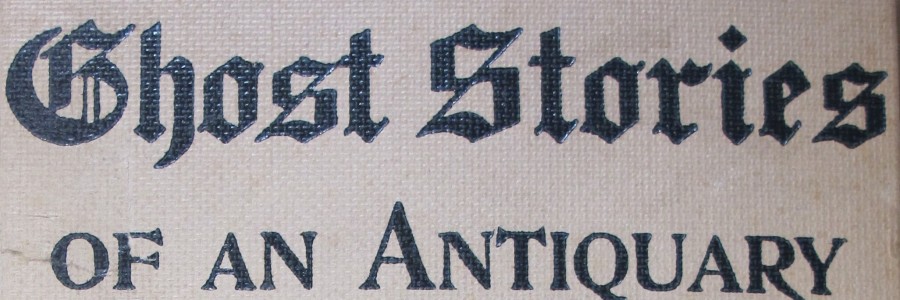
The ghostly world of M. R. James
Among the Library’s recent acquisitions is a privately printed ghost story by M. R. James, who died on this day in 1936. It is the first edition of his Wailing Well, printed in 1928 at the Mill House Press in the Berkshire village of Stanford Dingley, and which is now catalogued and available to readers. James was born in 1862 in the Kent village of Goodnestone. The family soon moved to Great Livermere in Suffolk, where James’ father was rector of the medieval church of St Peter; the rectory had been the childhood home of Thomas Martin (1697-1771), who went on to become one of the leading antiquaries of his day. In these promising surroundings James flourished, attending Eton before moving to King’s College Cambridge in 1882, where he won a host of academic prizes, becoming a fellow in 1887. His varied early publications included editions of Biblical texts, an account of the sculptures in the Lady Chapel at Ely Cathedral and a history of the abbey at Bury St Edmunds. By far his greatest scholarly undertaking was the vast series of catalogues of the manuscripts in Cambridge college libraries (in addition to others, including Eton and the Fitzwilliam Museum), which appeared between 1895 and 1914. Many colleges sent their manuscripts to his rooms in King’s so he could work on them at his leisure and the result has been called “a staggering achievement”. In many cases these catalogues remain the starting point for research on these collections today and at Trinity the text of James’ catalogue forms the backbone of the college’s ongoing project to digitise its medieval manuscripts.
James became Director of the Fitzwilliam Museum in 1893 (having been Assistant Director since 1886) and Provost of King’s in 1905, remaining there until 1918 when he returned to Eton as Provost (as the only individual to hold both posts). James began to write his ghost stories to be read aloud to his many friends at King’s, often on Christmas Eve and especially at meetings of the “Chit-Chat Club” for undergraduates. Some were first published in magazine form in the 1890s and the first collected edition appeared in 1904 as Ghost stories of an antiquary, with illustrations by the talented James McBryde, who died young in 1904 before the work was published. Further collections appeared in 1911 (More ghost stories of an antiquary), 1919 (A thin ghost and others) and 1925 (A warning to the curious and other ghost stories). The stories are united by the tripartite Jamesian themes of a characterful setting (church, village, country estate), a gentleman-scholar protagonist and an antiquarian object which in some way facilitates a ghoulish encounter. They grew out of James’ immersion in the past, fascination with medieval churches and love of old libraries and their contents. James’ style of ghost story has been admired and emulated by others, including the Librarian of King’s College (from 1947 until his death) A. N. L. ‘Tim’ Munby (1913-1974), whose Alabaster hand and other ghost stories was published in 1949 (and re-issued in 2013 for Munby’s centenary year) with a dedication to James. The two met when Tim was an undergraduate at King’s in the mid-1930s, James (by then in his seventies) giving him a small group of medieval manuscript fragments from his own collection, which were later sold as lot 5 at Sotheby’s (Western Manuscripts & Miniatures) on 17 December 1991.
Wailing Well concerns a group of boy scouts on a camping expedition who encounter something unpleasant in the well of the title (text available online here). Only 157 copies of this first edition were produced (the Library’s copy is numbered 157) and copies 1-7 were signed by James himself. The volume is rare in UK libraries, with other copies recorded at the British Library, the Bodleian Library, and Eton College. Eton have no fewer than five copies, three of which were presentated by James to his friends: one is inscribed to A. F. Scholfield, Cambridge University Librarian, and one is inscribed by several Eton boy scouts who were present at the first reading of the story by James. Our copy is made all the more special by the addition of a letter – now pasted inside – from James to Francis Bickley of the British Museum. The letter was written on 31 October but bears no year, though the fact that it is on Fitzwilliam Museum headed paper would suggest that it dates to James’ period of work there between 1886 and 1908, and probably in the latter part of that period. James writes to ask for information about an ancient manuscript catalogue of Norwich Cathedral Library, which he had seen described in an early eighteenth-century work as being a roll (rather than a bound codex) in the famous Cotton Library (collected by Sir Robert Cotton and gifted to the nation in 1702, becoming one of the founding collections of the British Museum in 1753). This research may have contributed to James’ article, “The library of the cathedral church of Norwich”, written with H. C. Beeching and published in the journal Norfolk Archaeology in 1915, which was subsequently used by the great scholar of medieval libraries Neil Ker in his “Medieval manuscripts from Norwich Cathedral Priory”, the first article in the very first issue (1949) of the Transactions of the Cambridge Bibliographical Society, the society having been founded in that year by a group including Tim Munby.
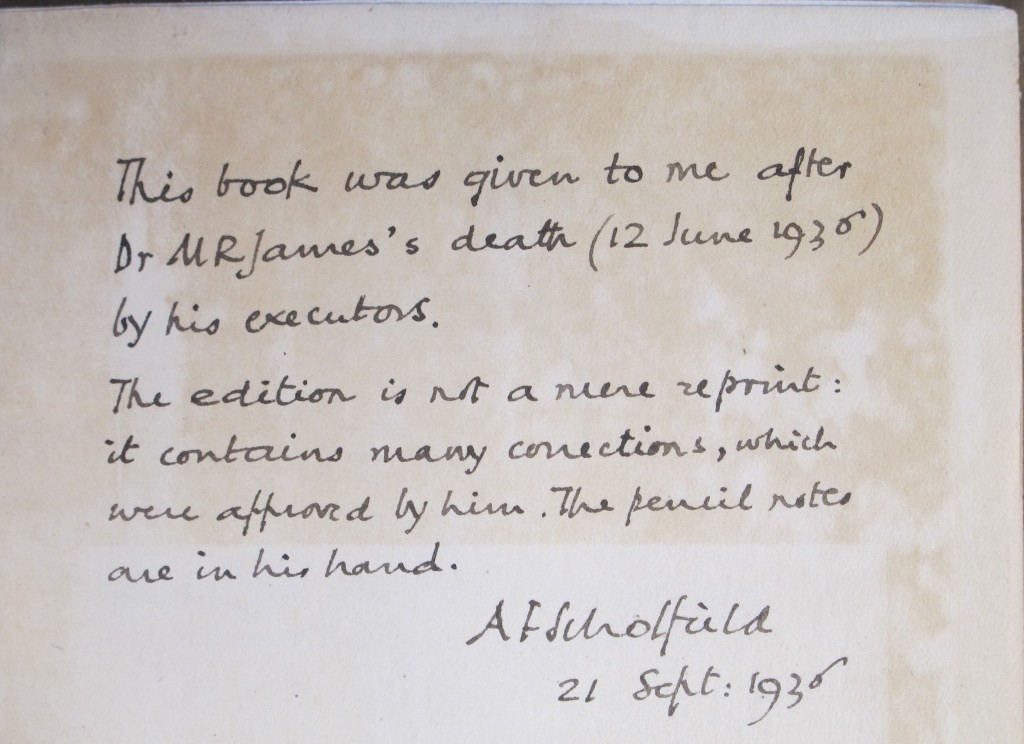
Note by A. F. Scholfield in James’ own copy of the 1919 ‘new edition’ of his “Ghost stories of an antiquary” (Adv.d.110.1)
James’ interest in old books – a number of his stories involves libraries or books – extended to his own collecting. The books from his library sold by Sotheby on 9 November 1936 (lots 1-137; ask in Rare Books for the annotated copy of the catalogue) included a fine illuminated Book of Hours of the fifteenth century (lot 58; sold for £60), an early thirteenth-century illuminated Psalter (lot 92; sold for £30) and a copy of Jacobus de Voragine’s Legenda aurea sanctorum (a collection of saints’ lives) printed in Lyons in 1494 (lot 136; sold for £12). The latter was bought by Sir Stephen Gaselee (Pepys Librarian 1908-1919) and presented to the University Library, where it is now Inc.3.D.2.23[4176]. It was formerly in the Franciscan monastery at Friburg and contains a list in James’ hand of “extra legends in the Aurea Legenda printed at Strasburg in 1483″.
The sale also included (lots 59-73) “The manuscripts of Dr M. R. James’s ghost stories … written entirely in his own hand … [and with] numerous corrections and alterations.” Lot 66, the manuscript of “The Stalls of Barchester Cathedral” (published in More ghost stories of an antiquary in 1911) reveals that the story was originally called “The Cat of Death”! We are also fortunate to have in our collections an interesting piece of James-iana: his own copy of the 1919 “new edition” of Ghost stories of an antiquary. The book contains a note by A. F. Scholfield, made in September 1936 some three months after James’ death, which reads “This book was given to me after Dr M R James’s death (12 June 1936) by his executors. The edition is not a mere reprint: it contains many corrections, which were approved by him. The pencil notes are in his hand.” Scholfield, University Librarian 1923-1949, presented the book to the Library later that year, and it forms part of our collection of Adversaria (printed books with manuscript annotations by known individuals).
James’ influence on modern ghost story writers and enthusiasts remains strong, as seen in the 2014 BBC4 documentary on his life and work by Doctor Who writer Mark Gatiss, in which he interviewed Canon Adrian Carey (now 94), who remembers meeting James during his time at Eton. We are certain that the addition of the rare first edition of Wailing Well to the Library’s collections will be of interest to scholars of James’ work and anyone who wishes to consult the volume is welcome to do so in the Rare Books Reading Room.

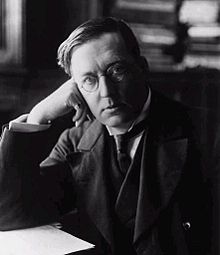
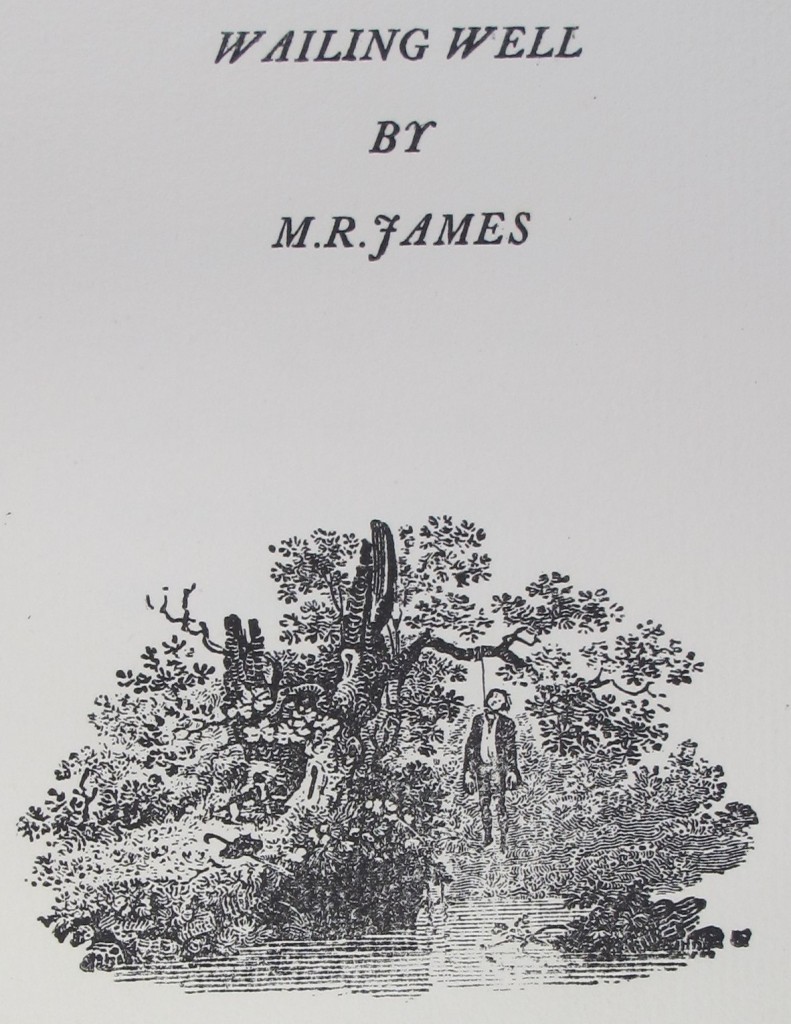
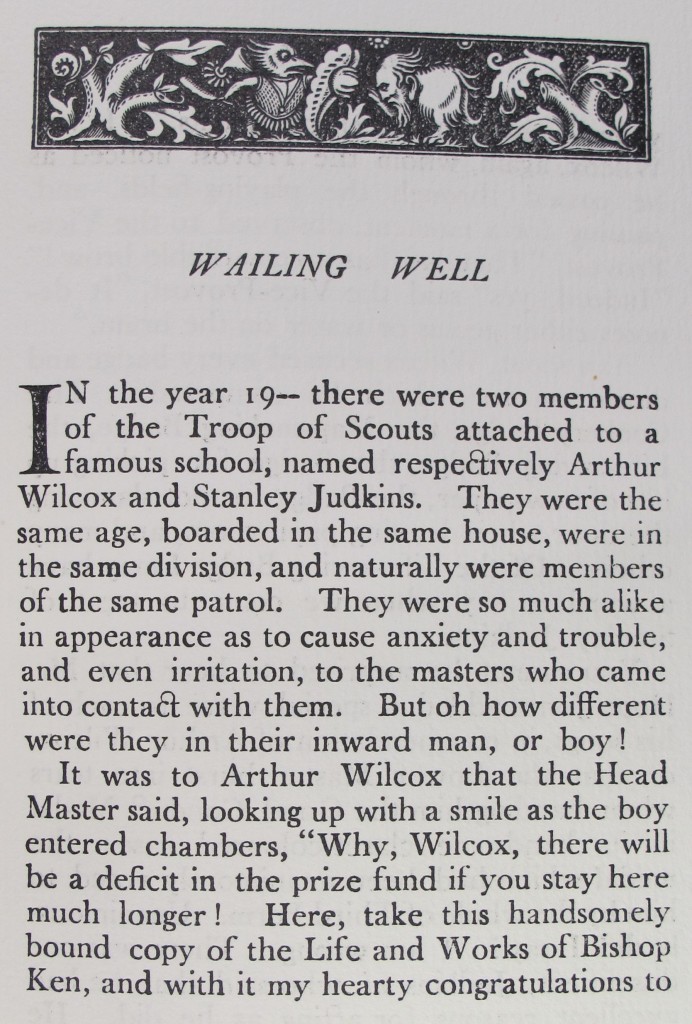
![Leaf aa2r of the Lyons Legenda, Inc.3.D.2.23[4176]](https://specialcollections-blog.lib.cam.ac.uk/wp-content/uploads/2015/06/Legenda-1024x904.jpg)
Interesting that the title page image is by Thomas Bewick – was this the author’s choice or the publisher’s?
Thanks for this Caroline. I hadn’t noticed it was Bewick, but I suspect it was the author’s choice. A quick Google reveals a mention of a “woodcut of Bewick’s” in his ‘Casting the Runes’. Geoffrey Keynes was also into Bewick and I don’t know if the two crossed paths. Certainly Keynes’ autobiography suggests that Gwen Raverat – who once “admitted she would like to have been Mrs Bewick” – rivalled Bewick in her own wood engraving, but again I don’t know if the Raverats/Darwins/Keyneses had much connection with or influence on James.
Hi I have a copy of this book the wailing well. Wouldn’t the library be interested? Copy number 154
Thank you Mark. As we have a copy already we’re not in a position to acquire a second, but thank you for your kind offer.
Hello,
Is the picture of M.R. James at the top of your web page copyright free? If not do you know who owns the copyright?
The context is that at Turton Tower, a small local authority run historic house we have been running a session for local school children on how to write a ghost story in the style of M.R. James. However, because of Covid-19 it may be a year before schools will visit us again.
We want to make a series of short films for our YouTube channel for use by local schools and it would be good to show a picture of Monty.
Can you advise?
Thanks for this. The image is in the public domain (I got it from Wikipedia: https://en.wikipedia.org/wiki/M._R._James#/media/File:MRJames1900.jpg) so it should be fine to use. Good luck with your project! Liam Sims (Rare Books Specialist).
I am astonished by the themes of warning against curiosity and the uncovering of secrets in the stories of James and the proximity of Cavendish Labotatory to the writer. It was the period that nuclear physics and indeed quantum mechanics were emerging. Does anyone know if James was aware of that ot met J.J. Thomson, his son or indeed Rutherford?….. all of whom were relevant to the birth of nuclear power and worked at the lab.
Thanks for this; very interesting! I’ll investigate. Liam.